Published: 29 Mar 2022
ETL Testing: A Detailed Guide for Businesses
Last Updated: 15 Jun 2022
For businesses, data forms the major element and essentially data transfer from one source to another should be taken up securely without any data loss. Businesses should ensure that the data is in the correct format and should be accurately processed, transformed, and loaded into the data warehouse. Further, as organizations develop, consolidate, and transform data to data warehouses, they should adopt the best practices and processes for loading and transforming data and ensure no data loss might affect them. The Extract, Transform, and Load (ETL) process is the primary process used to effectively load data from source systems to the data warehouse and ETL testing should be leveraged by businesses to ensure seamless data migration across sources.
Contents
1. What is ETL Testing?
2. An overview of ETL testing types
3. Major ETL testing benefits
4. What is data warehouse testing?
5. An overview of ETL Testing process
6. Some common types of bugs identified during ETL testing
7. Challenges faced by testers during ETL testing
8. Best practices to follow for successful ETL testing
9. Various ETL test automation tools
10. Conclusion
What is ETL Testing?

ETL stands for Extract, Transform, and Load testing, which includes a process of data extraction wherein Business Intelligence (BI) tools are used to extract the data from multiple sources, transform it into a consistent data type and load the data into a common storage or data warehouse. ETL testing ensures that the data extracted from heterogeneous sources and loaded into the data warehouse is accurate. It is a special testing type that ensures the data transfer occurs with strict adherence to transformation rules and complies with all validity checks. This special testing technique is a sub-component of data warehouse testing, and it ensures complete extraction, proper transformation, and adequate loading of data to the data warehouse.
An overview of ETL testing types
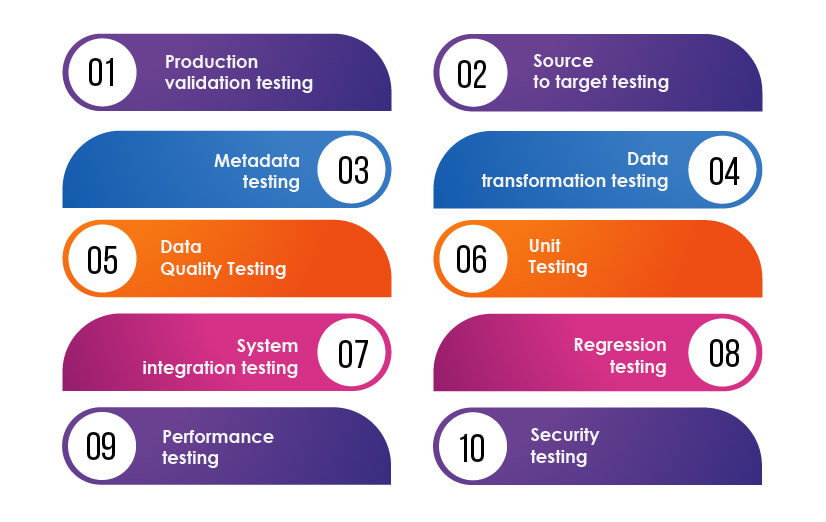
Production validation testing:
This type of testing is done on the data that is moved to production. It validates the source and destination data types to ensure the data is the same.
Source to target testing:
This testing type is performed to verify if the number of records loaded into the target database is the same or not. It also ensures data completeness by checking that the data gets added to the target without any loss/truncation.
Metadata testing:
This ETL testing type is performed to match schema, data types, length, indexes, constraints, etc., between source and target systems.
Data transformation testing:
In this testing type, SQL queries are run to validate that the data is correctly transformed according to the given business rules.
Data Quality Testing:
In this testing type, the data quality is checked by running various types of syntax tests (invalid characters, pattern, case order) and reference tests (number, date, precision, null check).
Unit testing:
In this testing type, the small components of ETL code are tested in isolation to ensure it works properly.
System integration testing:
In this testing type, the various components of ETL codes are integrated to ensure all components work well after integration.
Regression testing:
The main aim of ETL regression testing is to verify that the testing process enables the same output for a given input before and after the change.
Performance testing:
The main aim of the ETL performance testing approach is to ensure there are no bottlenecks and the ETL process can be completed with high volumes of data.
Security testing:
Data security is a major concern for all enterprises. Therefore, security testing during ETL is essential to ensure there are no vulnerabilities or security flaws in the data extracted and loaded into the data warehouse.
Major ETL testing benefits
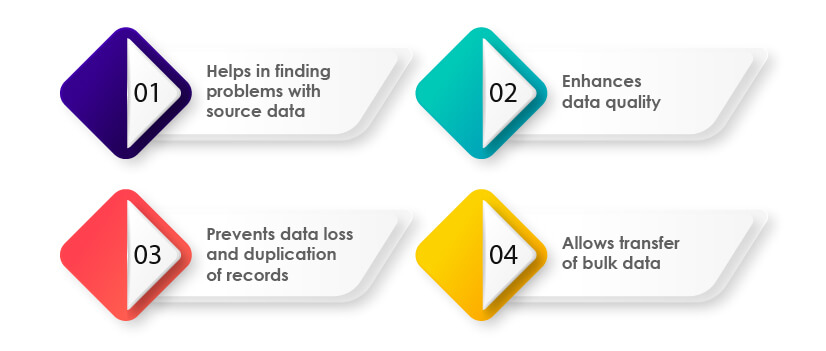
Helps in finding problems with source data:
During ETL testing, the ETL process helps testers to find problems in the source data even before loading it to the common repository.
Enhances data quality:
Since ETL testing ensures the removal of bugs from the source data, no bugs enter the data warehouse. This testing method ensures data completeness, data integrity, data correctness and ultimately enhances the data quality.
Prevents data loss and duplication of records:
Another benefit of ETL testing is that it ensures no data loss or data truncation happens due to invalid field length or other issues while data is loaded to the data warehouse.
Allows transfer of bulk data:
The ETL testing method ensures that bulk data transfer happens reliably and no data truncation or data discrepancy happens during the process.
What is data warehouse testing?
ETL testing and data warehouse testing are closely related as they share a common idea, i.e., to ensure high-quality, and bug-free data is loaded into the data warehouse. Data warehouse testing ensures that no bugs enter the data warehouse and validates the completeness and correctness of data. In this testing method, the data quality is validated across various stages of the data warehouse.
An overview of ETL Testing process
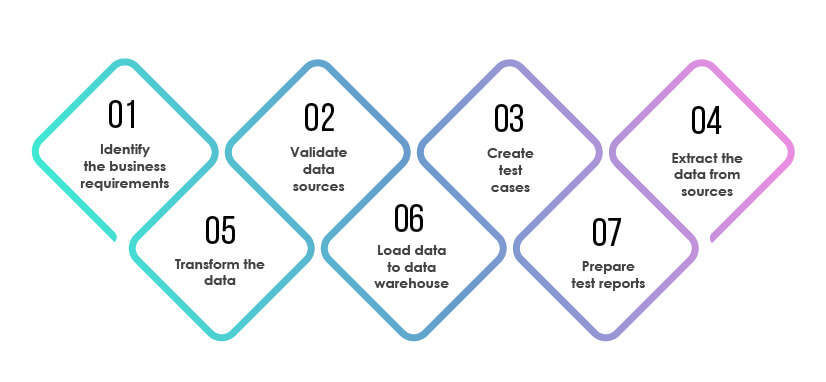
Identify the business requirements:
The first step in ETL testing is to understand the business requirements. The main aim here is to understand data needs and consider the risks and dependencies of data.
Validate data sources:
In this step, testers perform preliminary checks like schema checks, counts, validation of tables, etc., of the source data to ensure the ETL process aligns with the business model specification. It is also done to ensure no issues and duplication of records that otherwise would create problems during the ETL process.
Create test cases:
Once the data sources are validated, testers create test cases to check all possible data extraction scenarios from the source and data storage. Usually, test cases are written in SQL.
Extract the data from sources:
In this step, the data is extracted from the sources. Testers execute test cases to ensure there are no bugs in the source data and the data is extracted properly and completely.
Transform the data:
In this step, the data is transformed into an appropriate format for the target system. Testers ensure that the data transformed matches the schema of the target data warehouse. Essentially, testers also check the data threshold and alignment and validate the data flow.
Load data to data warehouse:
Finally, the data is loaded to the data warehouse, and testers perform a record count to ensure complete data is moved from the source to the data warehouse. Any invalid data is rejected, and it is also checked that there is no duplication or truncation of information.
Prepare test reports:
All the results and findings of the tests are documented in the test report to help the decision-makers know the details and results of the test.
Some common types of bugs identified during ETL testing
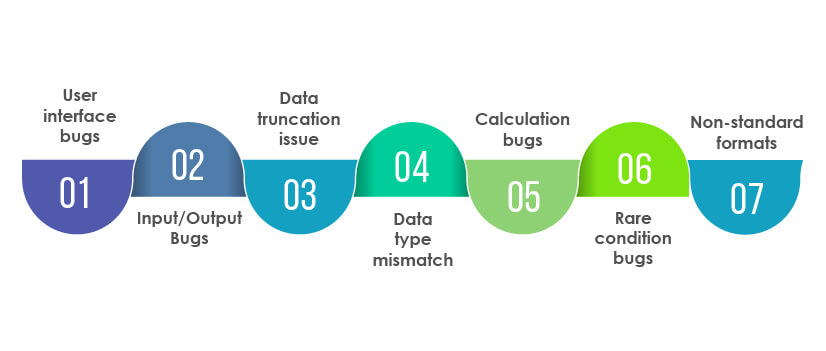
User interface bugs:
Spelling mistakes, wrongly placed uppercase or lowercase, issues with font size, font color, alignment, spacing, etc.
Input/output bugs:
Some valid values as per dataset are not present in the source table, Invalid values are present in the source table.
Data truncation issue:
Data getting lost due to invalid field length
Data type mismatch:
The data type of source and target table does not match with each other
Calculation bugs:
Mathematical errors, expected output after transformation are not correct.
Rare condition bugs:
System hangs, System not responding, or issues with client platforms
Non-standard formats:
Inconsistent formats between source and target databases
Challenges faced by testers during ETL testing

• A risk of data loss during ETL testing
• Unstable testing environment
• Duplicate data or incorrect/incomplete data
• A large volume of historical data makes ETL testing difficult
• Difficulty in building the exact or effective test data
• Lack of SQL coding skills makes ETL testing difficult
Best practices to follow for successful ETL testing
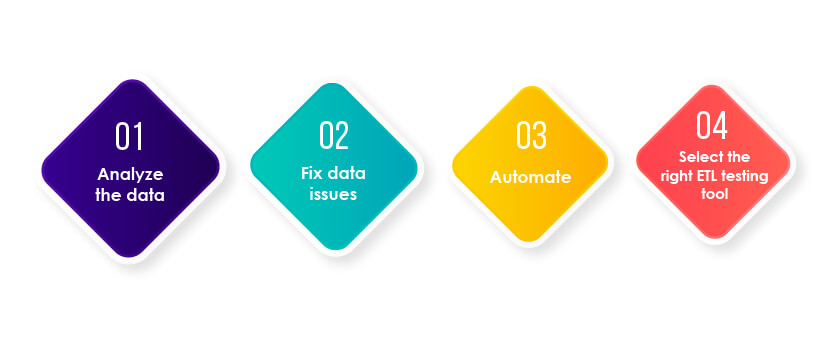
Analyze the data:
Testers need to analyze the data and understand the business requirements. Testers should document the business requirements, carefully study the source data and build the correct data validation rules to ensure successful ETL testing.
Fix data issues:
At times, incorrect data can severely affect business functioning. Therefore, it is essential to fix any data issue that arises in one run of the ETL cycle to ensure these issues do not repeat in the next cycle.
Automate:
Businesses are adopting agile and DevOps processes; therefore, the need for automated testing is increasing, and ETL testing is not an exception. Thus, automated ETL testing should be adopted to ensure an effective testing process to process a large volume of data in less time.
Select the right ETL testing tool:
Another important practice is to select the right and compatible testing tool for ETL testing. The ETL tool should be compatible with the source and target system and should generate SQL scripts to reduce processing time and resources.
Various ETL test automation tools
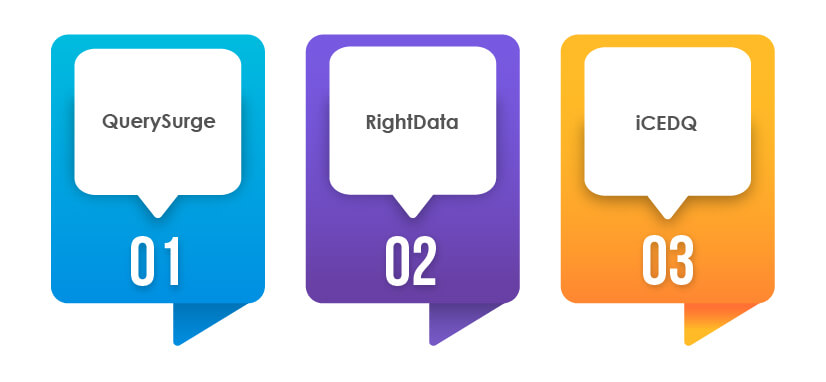
QuerySurge:
It is one of the smart ETL testing tools that leverage analytics for data validation and ETL testing. This tool can easily be used by novice and experienced testers. It comes with a Query Wizards feature that allows testers to validate data effectively and write custom codes. There are many benefits of using this tool. It allows data validation at speed, allows testing across platforms, integrates easily with Data Integration/ETL solutions, Build/Configuration solutions, and QA/ Test Management solutions.
RightData:
It is a self-service suite of applications that help achieve data quality, data integrity audit, and continuous data quality control with automated validation and reconciliation capabilities. This tool allows field-to-field data comparison, comparison, and contrast bulk data reconciliation and can be integrated easily with CI/CD tools. It allows testers to identify data consistency, quality, completeness, and gaps.
iCEDQ:
It automates end-to-end ETL testing with complete accuracy and increased coverage. This tool comes with a specific in-memory ETL testing engine that compares 100% of data. This ETL test automation tool can be connected to any heterogeneous data source and has an easy-to-use GUI to generate ETL tests, execute tests, and share the test results across the organization. This testing tool integrates easily with other tools like HP ALM, Jira, and Jenkins.
Conclusion
ETL Testing is critical to ensure the correctness and completeness of the ETL process. This testing procedure plays a vital role in Data Warehousing and helps to ensure data integrity while data is being extracted, transformed, and loaded to the data warehouse. This special testing process validates and verifies data to prevent data loss and duplication of records. Today, ETL Testing is gaining more significance due to the increased migration of high volumes of data. Businesses should leverage ETL testing from a next-gen QA and independent software testing services provider for seamless data migration from different sources.